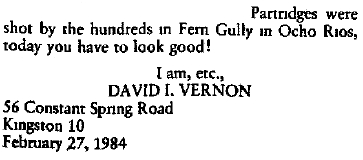Patrick Browne, The Civil and Natural History of Jamaica, 1756
'The Quail, commonly called a Partridge in Jamaica. These
birds were introduced there from North America, and set
loose in many parts of the island.'
and is found in such woods as are more choked with bushes than such as the Whitebelly prefers, though they often dwell together.
It is essentially a ground pigeon walking in couples or singly seeking for seeds or gravel on the earth. It is often seen beneath a
pimento picking up the fallen berries, the physic nut also and other oily seeds afford it sustenance, Sam once observed a pair of
these Doves eating the large seed of a mango that had been crushed. With seeds I have occasionally found small slugs a species of
Vaginulus common in damp places in its gizzard.



Daily Gleaner, September 2, 1962
W.
Stanley Moss
On Saturday last, guns were popping all over Jamaica. The shooting season, foreshortened now to two months span and restricting its participants to a 15-bird bag, had started.
We only collected a brace of Baldpate: but that didn't matter. It was the atmosphere which counted - the thrill of watching, stalking, and waiting, the smell of gunsmoke, the feel of a game-bag on your hip, the silent attention of a gun-dog at heel, the taste of fresh sandwiches and a swig of rum from the flask and good companions.
The variety of game-birds in Jamaica is rich and rare - Wild Duck, Mountain Witch, Whitewing, Baldpate, Ring-tai1, Lapwing, Pea Dove, White Belly, Blue Dove, Partridge and Paloma Pea Dove. There's romance and mystery in the names alone, not to mention the quality of taste in the eating.
In colder climates, of course, game-hlrds are left to get 'high' before making their appearance on the dinner table. (A pheasant is customarily hung by the tail until body and feathers part company.) In Jamaica this gastronomic exercise in patience and predilection is unnecessary. The bird is ready for
consumption within minutes of hitting the deck; but, as one old-stager told me, there are several ways of ensuring that your dinner will be just a little bit more exciting to the palate.
"The best eating," he said, “are birds which have been feeding off pimento. They've got built-in spicing."
Within recent memory, there was no restriction on shooting in Jamaica, and the season was much longer. During the past few years, however, the bag limit has been progressively reduced until now, with a maximum of 15 birds, there has come an effective stoppage to indiscriminate slaughter.
“You have to pick your birds nowadays,” continued my wise friend. “There's no point in simply blasting off in every direction. But I must confess that there are times, especially if a flight of duck comes overhead when the temptation to go over the limit is almost irresistible.”
. . . .
Then, too, there is the question of cost. Our neighbouring party, having pooled their resources for the week-end, worked out that each bird in their bag had cost them L14 (taking into consideration the several magnums of champagne and pots of caviare which they had consumed on the wayside.)



In A
Field Guide to the Birds of the West
Indies,
by Roger Tory
Peterson et al, 1999, p48,
the cry of the Ruddy Quail Dove is described as -
“A prolonged, booming note, reminiscent of the doleful sound of a fog-buoy.'
When was that cry last heard in Fern Gully?
FOOTNOTE:

Daily
Gleaner, March 15, 1993
A.
B. Anderson, of Tanglewood, St. Ann's Bay,
St. Ann, on:
Natural beauty
Fern
Gully is returning to its natural beauty.
The trees have again been providing the
amount of canopy which the
ferns need.
The reasons given for the decline in
the population and
quality of the ferns,
including that about exhaust fumes, can no
longer
be advanced.
Partridges which were once plentiful in Fern Gully might begin to re-appear.


